
Logarithm and exponential functions
Introduction
Logarithm and exponential functions are two sides of the same story, and among the widely used mathematical functions in science and engineering.
The natural logarithm
The function for the logarithm ln(x) is called LN(), i.e. if you need to calculate ln for a value in a cell you write =LN() in the cell, and in the bracket you write the name of the cell and/or mathematical expression you want to have processed.
For Microsoft Excel it looks like this:
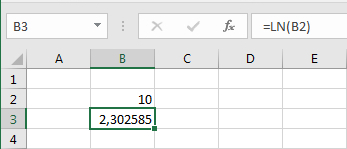
For OpenOffice Calc it looks like this:
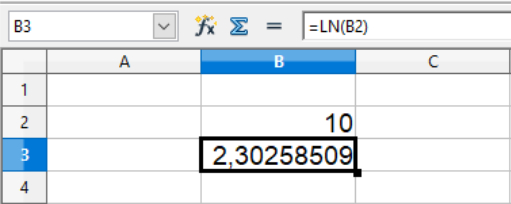
For Microsoft Excel it looks like this:

For OpenOffice Calc it looks like this:

The common logarithm
The function for the common logarithm, log(x), or base-10 logarithm, which is log10(x), is called LOG10(), i.e. if you need the cell to calculate the log value you write =LOG10() in the cell, and in the bracket, you write the name of the cell and/or mathematical expression you want to have processed.
For Microsoft Excel it looks like this:
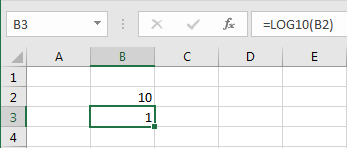
For OpenOffice Calc it looks like this:
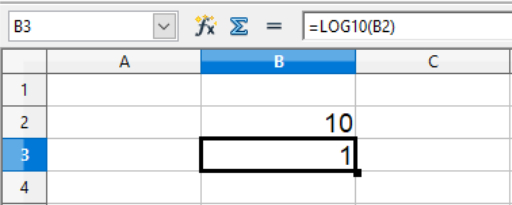
The function LOG() can also be used for the common logarithm. The function is really a generic function, as seen in the next section, but it is worth noticing, that if you don't specify the base number for the logarithm, the function uses base-10 as default.
For Microsoft Excel it looks like this:

For OpenOffice Calc it looks like this:

The function LOG() can also be used for the common logarithm. The function is really a generic function, as seen in the next section, but it is worth noticing, that if you don't specify the base number for the logarithm, the function uses base-10 as default.
Logarithms in general
Besides ln(x) and log(x), you can on occasion need other logarithms. Log(x) is implicit log10(x), i.e. the base-10 logarithm, and if you need e.g. log5(x), this is also doable. The syntax is LOG(value ; base), i.e. if you need the base-5 logarithm to the number 10, it looks like this: LOG(10;5). It is possible to insert both cell numbers and calculation for both the value and the base number, if needed. So, if you need log5(x) where x is the value in cell B2, it looks like this:
For Microsoft Excel it looks like this:
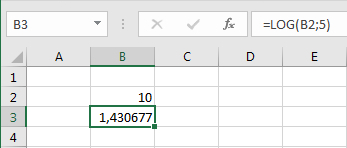
For OpenOffice Calc it looks like this:
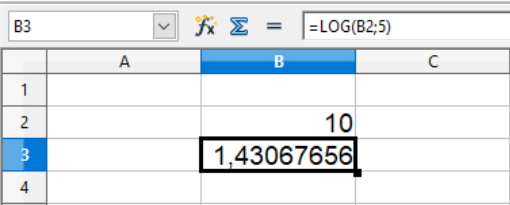
If no value is specified as the base number, the function uses 10 as the default value.
For Microsoft Excel it looks like this:

For OpenOffice Calc it looks like this:

If no value is specified as the base number, the function uses 10 as the default value.
Exponential functions
Exponential functions, i.e. a number to the power of x, can be done in two ways, depending on whether it is ex or one of the other exponential functions.
If we start with ex, which is also inverse ln(x), then the syntax is EXP(), i.e. if you need to calculate ecell B2, it is EXP(B2).
For Microsoft Excel it looks like this:
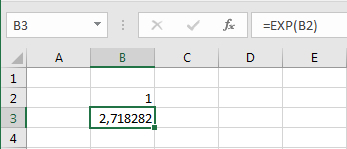
For OpenOffice Calc it looks like this:

Exponential functions that are not ex, is written using a circumflex, i.e. this character: ^. Thus, if you have the function 5x, where x is the value in cell B2, the syntax is 5^(B2). This is equivalent to the function inverse log5(x).
For Microsoft Excel it looks like this:
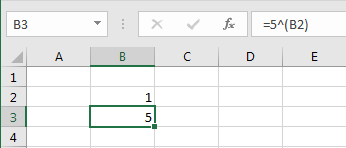
For OpenOffice Calc it looks like this:
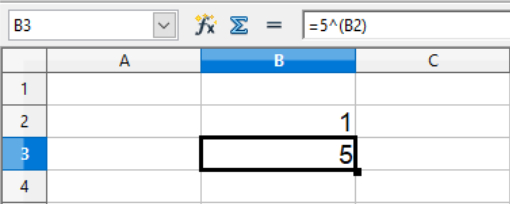
Should you need inverse log(x), which is really inverse log10(x), for the value in cell B2, the syntax is just 10^(B2).
For Microsoft Excel it looks like this:
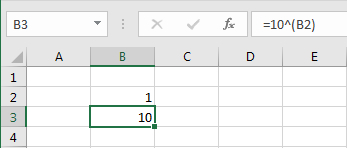
For OpenOffice Calc it looks like this:

If we start with ex, which is also inverse ln(x), then the syntax is EXP(), i.e. if you need to calculate ecell B2, it is EXP(B2).
For Microsoft Excel it looks like this:

For OpenOffice Calc it looks like this:

Exponential functions that are not ex, is written using a circumflex, i.e. this character: ^. Thus, if you have the function 5x, where x is the value in cell B2, the syntax is 5^(B2). This is equivalent to the function inverse log5(x).
For Microsoft Excel it looks like this:

For OpenOffice Calc it looks like this:

Should you need inverse log(x), which is really inverse log10(x), for the value in cell B2, the syntax is just 10^(B2).
For Microsoft Excel it looks like this:

For OpenOffice Calc it looks like this:
